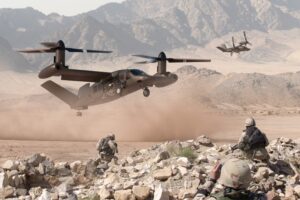
Bell V-280 Valor tiltrotor – artist’s rendering
AUSA: Bell Helicopter’s exhibit at this week’s Association of the United States Army convention includes a full-scale mockup of the V-280 Valor, the new tiltrotor the company is building. From the outside, it sure looks like a close cousin of the V-22 Osprey.
Under the skin, the V-280 seems a lot more like a prop-driven F-35. The first sign is six relatively small, round holes in the V-280’s composite skin. Those holes – two in the V-280’s nose, two near its V-shaped tail and one each on the top and bottom of the fuselage – are where Bell plans to install small video cameras, creating a Distributed Aperture System similar to one used by the F-35. As in the F-35, the imagery collected by those cameras will be quilted together by a computer program to create a live 360-degree view displayed on the visor of the pilot’s helmet, allowing him to see what’s under, above, in front of or behind the aircraft.
As Bell’s V-280 build manager, Scott Allen, told me when I visited Amarillo last month to see the actual V-280 work in progress, this Lockheed-supplied Pilotage Distributed Aperture System (abbreviated PDAS and pronounced “PEE-dass”), “turns the whole aircraft into Wonder Woman’s invisible jet, basically” — an analogy Lockheed reps also often use. But unlike the F-35, which carries just its pilot, the V-280’s PDAS imagery is to be sent to six special helmets, four for the Valor’s two pilots and two crew chiefs and two for commanders or others riding in the back cabin, which would hold 12 troops. The imagery could also be transmitted to screens in or far from the aircraft, just as the F-35 shares data with legacy aircraft like the F-16 and F-18, a stealth fighter like the F-22, Navy ships and other platforms. Why equip a relatively slow aircraft with high-tech sensors like this?
Vince Tobin, Bell vice president for advanced tiltrotor systems, said the PDAS can help V-280 pilots land safely in dust, sand, snow or other “degraded visual environments.” PDAS imagery could also be used by troop commanders in the back to spot enemy positions or terrain features that might interfere with an assault, letting them come up with better options as they approach their objective, which is why gunners and others behind the cockpit would get access to the data.
The PDAS also puts sensors such as those carried in turrets or externally by helicopters into the skin of the V-280, eliminating drag and weight.
Rita Flaherty, vice president for strategy at Lockheed Martin Missiles and Fire Control, said Northrop Grumman makes the F-35’s DAS but “we’ve got a lot of capabilities that lend themselves to Lockheed Martin developing a distributed aperture system for rotary wing.” Lockheed Missiles and Fire Control has made pilotage and targeting sensors for years for the Army’s AH-64 Apache attack helicopter, made by Boeing, and the Marine Corps AH-1Z Cobra, made by Bell, she said.
“It was only natural that, as the next generation of vertical lift is being developed, we would package some of the capabilities that we have into a new sensor system for those new rotary wing platforms,” she said.
Lockheed subsidiary Sikorsky is teamed with Boeing to build the SB>1 Defiant, a speedy compound helicopter expected to compete with the V-280 for future military contracts but Flaherty said her group has no contact with that project.
Alex Shepherd, a Missiles and Fire Control program manager, was quick to point out that Bell and Lockheed plan to install the PDAS in the V-280 only after the aircraft has completed its required flight testing under the Joint Multi-role Technology Demonstration (JMR TD) program. The JMR TD falls under the Army-led Future Vertical Lift initiative, which is focused on developing faster, more agile rotorcraft of all sizes for all the military services.
“For Bell’s initial flights, the Army requirement is just airspeed and agility tests,” Shepherd said. “This effort to demonstrate PDAS is a Bell- and Lockheed-funded effort and will be done after the Army tests.”
Shepherd added that the six PDAS-capable helmets envisioned for the V-280 will cost “nowhere close to” the F-35’s $400,000 helmet. The Army, he noted, “can’t afford F-35 helmets.” He also said that the service has a Common Helmet Mounted Display program in the works to develop new aircraft helmet displays.
PDAS isn’t the only capability Bell has in mind for the V-280 that could make it a prop-driven cousin of the F-35. The company is also designing mission packages that would arm the Valor with AGM-114 Hellfire missiles such as those carried by the Army’s MQ-1C Gray Eagle drone and with Lockheed’s new Joint Air-to-Ground Missile (JAGM), which has been test fired from the Army’s Gray Eagle and Apache and the Marine Corps’s Cobra attack helicopter. That could turn the V-280 into an attack aircraft. The F-35 can carry highly accurate and powerful cannon and, of course, a variety of missiles.
Once the JMR TD flights are done, said Chris Gehler, Bell’s V-280 program manager, “we’ll bring in many of the sensors of the F-35 type.” Discussions with the armed services have to come first, he said, “but we see a fused solution, so that a pilot can use a night vision goggle type or an IR or a heat-sensing type of approach through that PDAS system as well.”
If this sensor approach comes to fruition, the obvious question is, will the V-280 boast something like the F-35’s Fusion Center, which takes data from all the plane’s sensors, analyzes it and then advises the pilot about likely threats, including those from Electronic Warfare, surface-to-air and air-to-air missiles and cyber.
What will they think of next?
Navy jet trainer fleet operations remain paused after engine mishap
One week after the incident, a Navy spokesperson says the service is continuing to assess the fleet’s ability to safely resume flight.


























